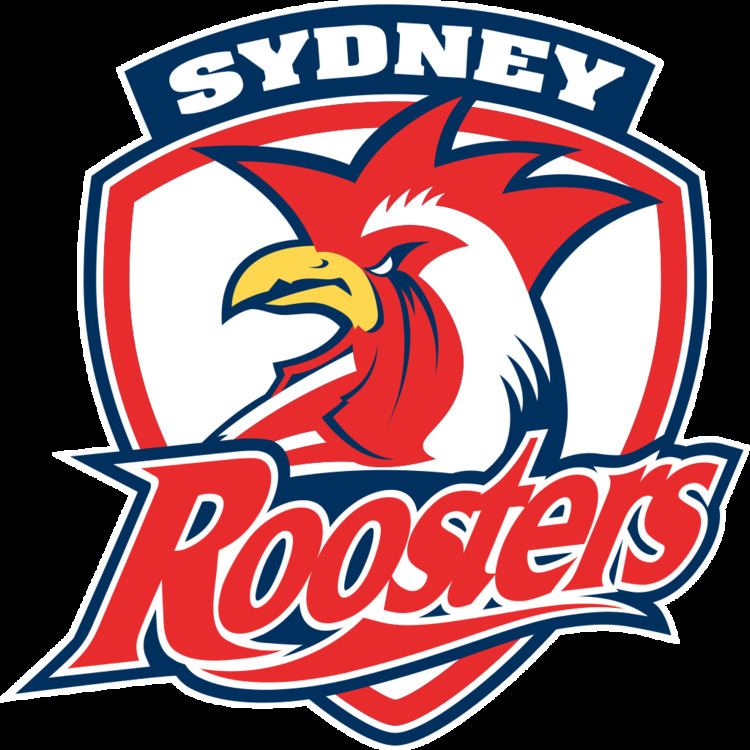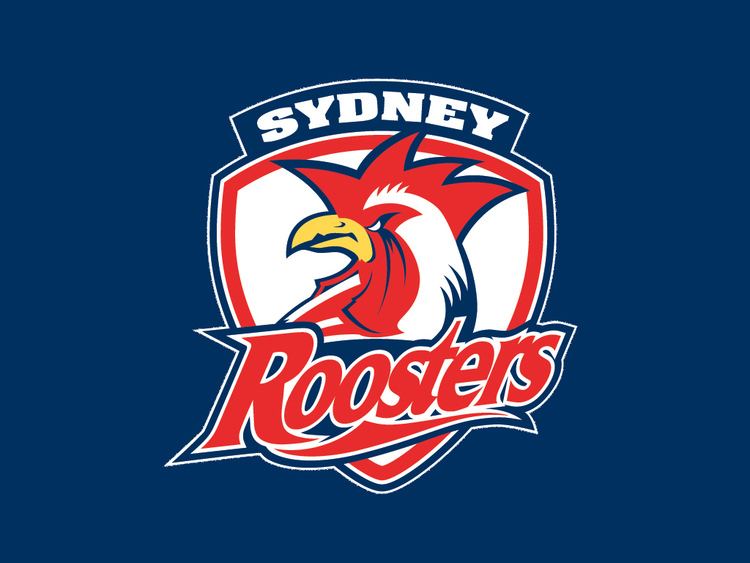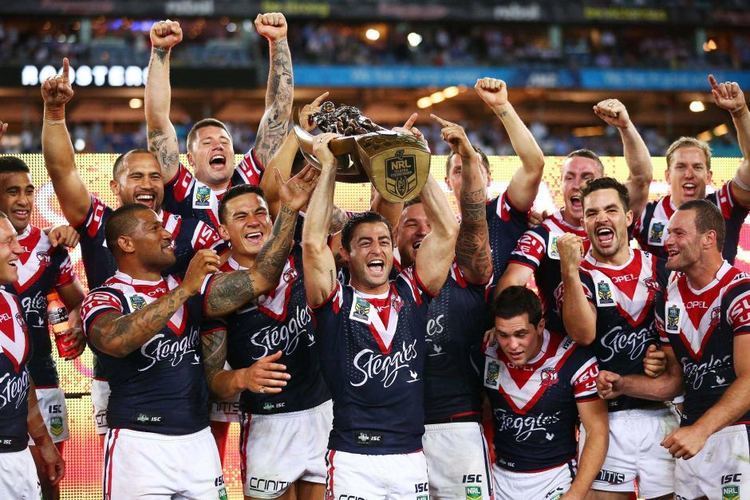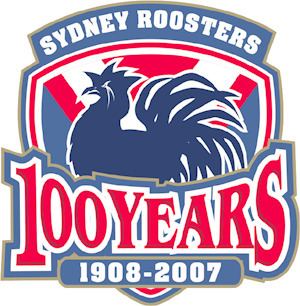Short name Sydney Roosters Colours Red, White, Blue Captain Jake Friend Location Sydney, Australia | Website roosters.com.au Arena/Stadium Allianz Stadium CEO John Lee (1 Mar 2016–) Founded 24 January 1908 | |
 | ||
Full name Eastern Suburbs District
Rugby League Football Club Nickname(s) Roosters, Easts, Tricolours Ground(s) Allianz Stadium
Moore Park, New South Wales (45,500) Coach Trent Robinson (Head coach) Profiles | ||
The Sydney Roosters are an Australian professional rugby league football club based in the Eastern Suburbs of Sydney. The club competes in the National Rugby League (NRL) competition and is one of the oldest clubs in Australian rugby league history, having won thirteen New South Wales Rugby League (NSWRL) and National Rugby League titles, and several other competitions. Only the South Sydney Rabbitohs and the St. George Dragons have won more premierships. The club holds the record for having the most wins and the second greatest margin of victory in a match in Australian rugby league history. The Eastern Suburbs DRLFC is the only club to have played in each and every season at the elite level, and since the 1970s has often been dubbed the "glamour club" of the league. Coached by Trent Robinson along with captains Boyd Cordner and Jake Friend, the Roosters play their home games at the Sydney Football Stadium.
Contents
- History
- Emblem
- Colours
- Geographic area
- Stadium
- Supporters
- Statistics and records
- Team of the Century
- The Centurions
- Major Titles
- Minor Titles
- References

The club was founded in 1908 in Paddington, Sydney, as Eastern Suburbs District Rugby League Football Club; in 1995 the club's marketing brand name was changed to the Sydney City Roosters and, in 2000, to simply the Sydney Roosters. The Bondi Junction and Moore Park-based Roosters have a long-standing and fierce rivalry with other Sydney-based clubs, especially the South Sydney Rabbitohs, a fellow foundation club based in neighbouring Redfern. Notwithstanding its branding as the Sydney Roosters, the official name of the club, holder of the NRL licence, remains the Eastern Suburbs District Rugby League Football Club, the same name it has had since 1908. As such, much of the club's merchandise and paraphernalia, especially those marketed directly to long-serving and dedicated members, includes the insignia ESDRLFC.

History

The Eastern Suburbs District Rugby League Football Club (ESDRLFC) was formed on 24 January 1908 at a meeting at the Paddington Town Hall in Sydney after it was decided that the district should enter a team in the newly formed New South Wales Rugby Football League. The ESDRLFC was formed, under its articles of association with the NSWRL, to represent the geographic areas in Sydney covering the Waverley, Randwick, Woollahra, Paddington, Darlinghurst and Vaucluse local government municipalities, as well as the eastern parts of the Sydney CBD. Indeed, the 'suburb' of Sydney, postcode 2000, falls entirely within the official boundaries of the ESDRLFC.

Unofficially nicknamed the "Tricolours" due to their red, white and blue playing strip, Eastern Suburbs won its first match, defeating Newtown 32–16 at Wentworth Oval on 20 April 1908. In 1913, they became the first club to win three consecutive premierships; the line-ups during this period included the likes of Dally Messenger, Harry "Jersey" Flegg and Sandy Pearce, all regarded as all-time rugby league greats. However, the club rapidly declined and failed to win the premiership for the next nine seasons.
Eastern Suburbs missed the finals once from 1926 to 1942, and in that time won four titles and the minor premiership on seven occasions. During this period, Dave Brown set several point-scoring records that still stand. In 1935, the team lost just one game, and recorded the highest winning margin in their history, an 87–7 (106–8 in modern scoring) victory over Canterbury. In 1936, Eastern Suburbs became one of five teams in premiership history to remain undefeated for an entire season, a feat they repeated the following year. They are the only club to remain unbeaten for two consecutive seasons.
Despite claiming the premiership in 1945, Eastern Suburbs failed to make the finals for the following seven seasons. A runners-up finish in 1960 was the closest the club came to claiming the premiership during this era. Eastern Suburbs were soundly defeated 31–6 in the grand final that year, by the famous record-beating St George outfit. In 1966, the club fell to new depths and was winless for the first time in its history. It was also the last occasion in which the Roosters won the wooden spoon until claiming it again in the 2009 season. It ended a poor run for Eastern Suburbs; from 1963 to 1966, they won 8 of 72 matches, finishing second to last in 1964 and last in the other three years. The club underwent a renaissance in 1967 after appointing Jack Gibson as coach (1967–68), and introducing a new emblem on the playing jerseys, the rooster.
From 1972 to 1982, the Roosters won four minor premierships and played in four grand finals, winning two consecutively. Gibson, now dubbed as "Super Coach", returned to lead the team from 1974 to 1976. In 1974 and 1975, the team won 39 of 44 matches, both minor premierships, and both grand finals and set a premiership record of 19 consecutive wins. The 38–0 grand final victory in 1975 against St George was the largest margin in a first grade grand final, and the record stood for 33 years until superseded by Manly's 40–nil win over the Melbourne Storm in 2008. With line-ups including Mark Harris, Elwyn Walters, John Brass, Bill Mullins, Russell Fairfax, Johnny Mayes, John Peard, Ron Coote, Ian Schubert and captain Arthur Beetson, the Centenary of Rugby League panel considered the Roosters of 1974 and 1975 to be among the greatest club teams of all time.
Between 1984 and 1995, the Roosters reached the semi-finals once, and became known to critics as the "transit lounge", due to the high frequency of player purchases and releases. The club came close to reaching the premiership in 1987 under coach and favourite son Arthur Beetson, being defeated by eventual premiers Manly in a "bruising" major semi-final, 10–6.
As the Super League war built up in the mid-1990s, the Roosters recruited high-profile coach Phil Gould and star five-eighth Brad Fittler, both from the Penrith Panthers. This helped to quickly send the Roosters back to the upper end of the ladder. Fittler's presence proved invaluable; during his reign, the Roosters competed in four grand finals in five years. In 2002, the club captured its 12th premiership — the first in 27 years — defeating minor premiers the New Zealand Warriors 30–8 in the 2002 NRL grand final.
In the 2003 NRL grand final against the Penrith Panthers, the Roosters lost 18–6 in what was their heaviest defeat for the year. A decisive moment occurred midway through the second half: with the scores tied at 6-all, Roosters winger Todd Byrne made a clear break down the sideline and looked set to score a try before being chased down and tackled into touch by Penrith lock forward, Scott Sattler. From then on, the momentum of the game was with Penrith. The Roosters' made the Grand Final in 2004, when they ceded a 13–6 half-time lead to be defeated by the Bulldogs 16–13. The match was captain Fittler's last for the team.
In 2007, the Roosters became the first club to play 100 seasons of first grade rugby league; they were the only outfit to play in each season since the competition's inception in 1908. They appointed Chris Anderson as coach in 2007 and 2008 following two relatively unsuccessful years under Ricky Stuart. On 9 July 2007, Anderson resigned after a 56–0 loss to the Manly-Warringah Sea Eagles. Assistant Coach Fittler acted as the caretaker for the remainder of the 2007 season, before being appointed in August to the top job for two years. With eight rounds remaining in a disappointing 2009 season in which the Roosters finished with the wooden spoon for the first time in 43 years, Fittler was informed he would not be the coach in 2010, his position to be taken by veteran coach Brian Smith. The Roosters wound up winning only five games for the entire season; twice against Cronulla and once against each of Canberra in Canberra, eventual grand finalists Parramatta and Newcastle in Newcastle.
A year after finishing last, under the coaching of Brian Smith they reached the 2010 NRL Grand Final where the St. George Illawarra Dragons defeated them 32–8. The Roosters led 8–6 at half time but were overrun in the second half.
What followed was another relatively disappointing season at Bondi Junction, with the Roosters finishing 11th in a 2011 season plagued by off-field issues involving 2010 Dally M Medallist Todd Carney (who was later sacked by the Roosters at season's end). However, a four-game winning streak to end the season brought hope for the 2012 season. Other high-profile players including Nate Myles, Mark Riddell, Jason Ryles, Kane Linnett and Phil Graham all left the club at season's end.
The Roosters endured a disappointing 2012 season, finishing 13th. Brian Smith resigned from the coaching role shortly after the Roosters' season concluded with a loss to the minor premiers Canterbury, and also at season's end captain Braith Anasta left to join the Wests Tigers in 2013.
The 2013 season saw new staff, a new coach, Trent Robinson, and several new players, including big signings Michael Jennings, James Maloney, Luke O'Donnell and Sonny Bill Williams, arrive at the club. This culminated in the Roosters finishing the 2013 season with a 24–12 win over the South Sydney Rabbitohs, securing the minor premiership for the 2013 season and were the NRL's best attacking and defensive team. The Roosters defeated the Manly-Warringah Sea Eagles 4–0, in week one of the finals, earning a week's rest. The Roosters defeated the Newcastle Knights 40–14 in week three of the NRL finals, progressing to the 2013 NRL grand final, facing the Manly-Warringah Sea Eagles, winning 26–18. It was a great comeback by the Roosters, down by 10 points in the second half they went on to score three consecutive tries to seal the win and their 13th premiership. They then went on to win the 2014 World Club Challenge against Wigan 36–14 to claim the treble of club titles. No team in premiership history had come from a lower ladder position to win the following season’s title.
Emblem
Eastern Suburbs did not traditionally sport a crest on their jerseys in the first half of the 20th century. Other clubs occasionally sported simple designs on their strip; however, this was not seen consistently on all jerseys until the 1950s and 1960s. In 1967, the club introduced the first logo, displaying the motto "Easts to Win", following a winless season. The crest also incorporated a rooster or cockerel in the design; one source suggested that this choice of mascot followed after the Roosters' jersey design was inspired by the French national team's jersey. Given that the French team's mascot was affectionately known to supporters as le coq, "the rooster", connections have been made as to the choosing of a rooster for Eastern Suburbs' mascot.
In 1978, the motto was replaced with the team's name, "Eastern Suburbs". This name was kept until 1994, when the club changed its playing name to the "Sydney City Roosters" for the start of the 1995 season to expand the club's widening fan base. In 2000, the club changed its name to the "Sydney Roosters".
Although marketing names have changed, the Roosters are still registered with the National Rugby League competition as the Eastern Suburbs District Rugby League Football Club.
Colours
Red, white and blue have been the colours of every jersey design in the club's history; however, the jersey design has undergone several alterations. The red, white and blue colour scheme has traditionally been the colour combination of sporting teams representing Sydney's Eastern Suburbs. Eastern Suburbs Rugby League club adopted these colours in 1908, with its predecessor Rugby Union club, also known as Eastern Suburbs in the Sydney club Rugby Union, having played in the tri-colours. The jersey worn in the first premiership season consisted of several hoops; red stripes dominated over consecutive smaller white and blue stripes. Although the width and the order of these stripes have changed, the basic design has always been maintained.
During World War II, the design of the jersey was modified because the dye used to colour jerseys was needed for the war effort. This saw Eastern Suburbs playing in different colours and an altered design. Instead of using the traditional hoops, the side used a sky-blue based jersey and a red and white V-strip around the collar. This is the only noted time in the club's history where the traditional deep blue, red and white combination was absent from the jersey. After the war, the V-strip design reverted to the original blue that had been present in the original jerseys, and the single red and white stripes around the shirt's chest were incorporated with a single white stripe surrounded by a red stripe on either side. This jersey appeared in the 1950s and remains the team's base design.
Facing design clashes with other teams in the 1990s, the club adopted a jersey with a similar design to what became known as the "away jersey", replacing the blue backing with white, and the outer red stripe with blue. As the club entered the new century, the team began to wear a "foundation jersey". Although the design differs slightly from the jersey worn in the inaugural 1908 season, it did feature the traditional horizontal striped-design. This jersey is normally worn when the Sydney Roosters face traditional rivals, such as the South Sydney Rabbitohs, or on special occasions such as Anzac Day when the team meets the St George Illawarra Dragons, the product of a team partly formed by the St. George Dragons.
Geographic area
The Sydney Roosters, namely the Eastern Suburbs District Rugby League Football Club was formed, under its articles of association with the NSWRL, to represent the geographic areas in Sydney covering the Waverley, Randwick, Woollahra, Paddington, Darlinghurst and Vaucluse local government municipalities, as well as the eastern parts of the Sydney CBD. Despite some junior Rugby League boundaries being redrawn over the 107-year history of the code in Australia, these articles of association remain unchanged. As such, the Roosters represent a small area of Sydney. The Roosters home turf is also home to a large number of supporters of rival codes and thus is the most competitive sporting market in Australia, with the Roosters flying the flag for Rugby League in Sydney's east.
Stadium
Most sources suggest that the Royal Agricultural Ground was often used as a home venue between 1908 and 1910, before the club hosted matches at the Sydney Sports Ground from 1911 onwards. It was here that the team played all of their home games up until 1986, when the ground was demolished with the Sydney Cricket Ground No. 2 to make way for Sydney's main rectangular field, the Sydney Football Stadium. In 1987, games were moved away to the Newtown Jets' home ground, Henson Park, temporarily to await the completion of the Sydney Football Stadium. The team capitalised on this move, finishing second in the regular season. It was the only time between 1983 and 1995 that the side reached the finals.
In 1988, the club moved to the newly built Sydney Football Stadium on the site of the old Sydney Sports Ground, opening the season with a 24–14 defeat at the hands of the St George Dragons in front of 19,295 spectators on a wet night on 4 March 1988. At the Sydney Football Stadium, the Roosters have a 59% win record from 256 games with a 58% and 55% win record at their old grounds the Sydney Sports Ground and the Sydney Cricket Ground respectively.
In 2022 Allianz stadium will be upgraded at a cost of $450 million and is expected to take 4 years to complete. The Roosters are expected to play their Home games during this period at ANZ or Central Coast Stadium. Once completed the club is expected to call Allianz home again.
Supporters
The Sydney Roosters have a strong supporter group base across Australia. Aside from its traditional fan base in Sydney, which is most concentrated in its homeland in the affluent eastern suburbs. The club has an internet message board for supporters, "The Wall", which has been the official forum since 1999. The club has announced that "The Wall" will be closing as of late January 2012. "The Chookpen" is an unofficial site.
In 2013 the club tallied the fourth-highest home attendance of all National Rugby League clubs (behind the Brisbane Broncos) with an average of 19,368 spectators at the Sydney Football Stadium.
At the club's home ground, the Sydney Football Stadium, the supporters congregate in distinct sections. The "Chook Pen", a designated area in Bay 35, is the preferred location for the most animated fans. Members of the Sydney Cricket and Sports Ground Trust are seated in the Members' Stand on the western side of the ground, and season ticket holders are located just beneath the Members' area, in Bays 12–14.
In 2014, the Roosters had nearly 17,000 paying members, in addition to the 45,550 members of the Roosters' Leagues Club, which is the major benefactor of the football club. The Easts Leagues Club and the Sydney Roosters "operate as one entity" known as the Easts Group. Under this arrangement, the Eastern Suburbs District Rugby League Football Club is the 'parent company' of the Easts Group. The Football Club delegates, however, overarching responsibility for both football and leagues club operations to a single general manager who oversees the whole group's performance. The leagues club group provides financial support to the football club, only where necessary, as in recent years the football club's sponsorships and TV revenues are generally covering most Rugby League expenditures.
Statistics and records
Anthony Minichiello holds the record for the most first grade games (302), having surpassed Luke Ricketson's tally of 301 matches in round 3 of the finals in 2014. Former team captain Craig Fitzgibbon holds the club record for scoring the most points, tallying 1,376 over his 210 matches. Fitzgibbon also broke the all-time point scoring record for a forward in the later rounds of 2006. Dave Brown's tally of 45 points (five tries and 15 goals) in a single match against Canterbury in 1935 remains a competition record after more than seven decades. Ivan Cleary scored 284 points in 1998, which at the time was an all-time points scoring record in a season.
Bill Mullins, father of 2002 premiership player Brett, scored 104 tries in his 11-year, 190-game career with Eastern Suburbs between 1968 and 1978, meaning that on average, he scored at least one try every two games. Anthony Minichiello became the highest try scorer in the Roosters history when he scored his 105th try against the Newcastle at Ausgrid Stadium in June 2011. 'Mini' finally retired after the 2014 season, and ended his career with 139 tries. He is also the first fullback in 70 years to win the Grand Final (2013), whilst captaining the Club. Rod O'Loan scored seven tries in a single match against Sydney University in 1935, and Dave Brown's 38 tries in 15 games in the same year remains a competition record.
In 1975, the Eastern Suburbs Roosters set an unparalleled 19-match winning streak on their way to their 11th premiership. In a 1935 match against Canterbury, Dave Brown scored 45 points, the highest score and victory margin for the club (the 87–7 scoreline is equivalent to 106–8 under the contemporary scoring system). The winning margin is the second largest overall, behind St. George's 91–6 win over Canterbury a week earlier.
The club's record attendance for a regular season game at its home ground—the Sydney Football Stadium—stands at 40,752, achieved in a match on ANZAC Day against the St George Illawarra Dragons in 2013. The 2000 grand final between the Sydney Roosters and the Brisbane Broncos attracted 94,277 spectators to the Olympic Stadium.
Team of the Century
In 2000, the Sydney Roosters named their "Team of the Century", which included players from 1908 to 2000. The official team is listed below along with their Sydney Roosters cap number.
The Centurions
In 2007, the Sydney Roosters announced "The Centurions", a team consisting of those regarded as the greatest players to have played 100 or more games for the club between 1908 and 2007. The team was selected by Ray Chesterton, Ian Heads, David Middleton and Alan Clarkson and was unveiled at the centenary season launch at the Michael Algeri Pavilion on 10 March 2007.
Major Titles
Premierships – 13
1911, 1912, 1913, 1923, 1935, 1936, 1937, 1940, 1945, 1974, 1975, 2002, 2013
Runners-up – 15
1908, 1919, 1921, 1928, 1931, 1934, 1938, 1941, 1960, 1972, 1980, 2000, 2003, 2004, 2010
Minor Premierships – 19
1912, 1913, 1923, 1931, 1934, 1935, 1936, 1937, 1940, 1941, 1945, 1974, 1975, 1980, 1981, 2004, 2013, 2014, 2015
World Club Challenge – 3
1976, 2003, 2014
Minor Titles
Club Championship – 14
1930, 1931, 1934, 1935, 1936, 1937, 1945, 1970, 1974, 1975, 2004, 2006, 2013, 2014
Second Grade – 9
1908, 1909, 1910, 1911, 1935, 1937, 1949, 1986, 2004
National Youth Competition – 1
2016
Jersey Flegg Cup – 14
1914, 1917, 1924, 1929, 1930, 1931, 1932, 1941, 1947, 1970, 1976, 1993, 2002, 2004
Presidents Cup – 15
1910, 1911, 1913, 1920, 1922, 1923, 1924, 1927, 1938, 1948, 1949, 1955, 1978, 1987, 1993
S. G. Ball Cup – 4
1997, 2008, 2010, 2014
Amco Cup – 2
1975, 1978
City Cup – 3
1914, 1915, 1916
Pre-Season Cup – 4
1974, 1977, 1979, 1981
Auckland Nines – 1
2017
World Sevens – 1
1993
